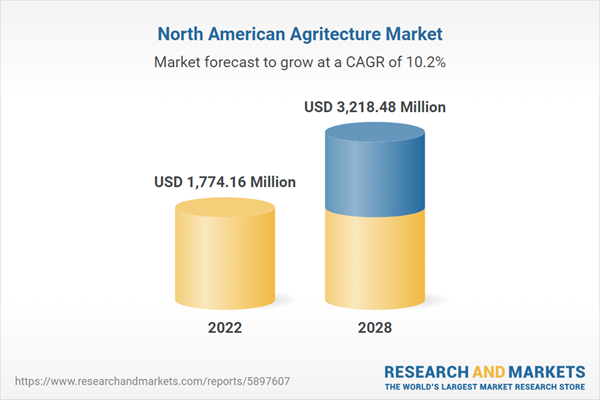Speak directly to the analyst to clarify any post sales queries you may have.
10% Free customizationThis report comes with 10% free customization, enabling you to add data that meets your specific business needs.
The North America Agritecture Market has experienced significant growth in recent years, driven by factors such as increasing urbanization, rising demand for sustainable and locally sourced food, and advancements in agricultural technologies. The market encompasses a wide range of applications, including indoor vertical farming, rooftop gardens, greenhouses, and aquaponics systems.
Key Market Drivers
Growing Demand for Vertical Farming and Modular Systems
Vertical farming and modular agritecture systems have emerged as transformative solutions for urban food production in North America. With urbanization limiting available farmland, vertical farming maximizes space by stacking crops in controlled indoor environments. This method enables year-round cultivation regardless of weather conditions, ensuring a continuous supply of fresh produce. Additionally, vertical farms use hydroponics and aeroponics, which consume up to 90% less water than traditional soil-based agriculture. This makes them highly efficient and sustainable, addressing concerns related to water scarcity.Modular agritecture systems further enhance scalability by allowing businesses to start with small, cost-effective units and expand operations as demand grows. According to the USDA, representative surveys indicate that farmers utilize conservation tillage on a significant portion of cultivated land, including 68% of wheat acres, 76% of corn acres, and 74% of soybean acres.
However, its adoption is comparatively lower for cotton, covering only 43% of acres. No-till farming, a subset of conservation tillage where crops are planted directly into residual crop matter without prior tillage, has seen notable growth in wheat and corn production over the past two decades. The share of wheat acres under no-till increased from 20% in 2004 to 39% in 2009, reaching 45% by 2017. Similarly, no-till adoption for corn expanded from 16% in 2001 to 36% in 2021, with a notable rise from 28% in 2016.
Key Market Challenges
Regulatory Hurdles
One significant challenge facing the North America Agritecture Market is regulatory hurdles. The complex web of regulations governing agriculture, land use, and building codes can pose obstacles to the implementation of agritecture solutions.Many municipalities have zoning laws designed for traditional agriculture or urban development. Agritecture often doesn't fit neatly into these categories, leading to zoning conflicts. Building codes may not account for the unique structures and systems used in agritecture. Compliance with existing codes can be costly and time-consuming. The safety of urban-grown produce is a concern. Agritecture ventures must navigate a complex web of food safety regulations, which can be particularly challenging for startups. The need for compliance with various regulations can increase costs, extend project timelines, and create uncertainty for investors. Addressing these challenges often requires advocacy, dialogue with regulatory bodies, and industry-wide standards to streamline the adoption of agritecture solutions.
Key Market Trends
Sustainable Farm-to-Table Initiatives
In North America, sustainable farm-to-table initiatives have gained significant traction due to rising consumer awareness about environmental impact and food safety. Consumers are increasingly seeking fresh, locally sourced produce that reduces carbon emissions associated with transportation. Agritecture, which integrates agriculture with architecture, enables year-round production in urban settings, eliminating reliance on long-distance supply chains. This approach not only reduces emissions but also minimizes food spoilage and waste during transit. Additionally, agritecture enhances food safety by offering transparency regarding sourcing, cultivation methods, and pesticide usage.High-profile foodborne illness outbreaks have fueled demand for traceable and accountable food systems, further driving adoption. Restaurants and retailers, responding to this demand, are forging partnerships with agritecture farms to ensure a steady supply of fresh ingredients. The farm-to-table movement is particularly strong in urban centers where space constraints make traditional farming challenging. Agritecture allows businesses to cultivate fresh produce on-site or within close proximity, creating a hyper-local food ecosystem.
Furthermore, sustainability regulations and incentives support businesses that adopt such initiatives, providing financial and operational benefits. The appeal of sustainable farm-to-table initiatives is also driven by shifting consumer preferences toward ethical and eco-friendly consumption. Agritecture-based farm-to-table models enhance customer trust and loyalty, ultimately benefiting businesses through premium pricing and brand differentiation. As demand for sustainable food options continues to rise, agritecture is poised to become an integral part of the North American food supply chain.
Key Market Players
- Eden Green Technology
- Elevate Farms Inc.
- iFarm Corp
- OSRAM GmbH
- Plenty Unlimited Inc.
- AeroFarms LLC
- Sky Greens Inc
Report Scope:
In this report, the North America Agritecture Market has been segmented into the following categories, in addition to the industry trends which have also been detailed below:North America Agritecture Market, By Integration:
- Indoor
- Outdoor
North America Agritecture Market, By Structure:
- Retrofitting
- Extension
- New Building
North America Agritecture Market, By Application:
- Residential
- Commercial
North America Agritecture Market, By Country:
- United States
- Canada
- Mexico
Competitive Landscape
Company Profiles: Detailed analysis of the major companies present in the North America Agritecture Market.Available Customizations:
With the given market data, the publisher offers customizations according to a company's specific needs. The following customization options are available for the report.Company Information
- Detailed analysis and profiling of additional market players (up to five).
This product will be delivered within 1-3 business days.
Table of Contents
Companies Mentioned
- Eden Green Technology
- Elevate Farms Inc.
- iFarm Corp
- OSRAM GmbH
- Plenty Unlimited Inc.
- AeroFarms LLC
- Sky Greens Inc
Table Information
| Report Attribute | Details |
|---|---|
| No. of Pages | 132 |
| Published | February 2025 |
| Forecast Period | 2022 - 2028 |
| Estimated Market Value ( USD | $ 1774.16 Million |
| Forecasted Market Value ( USD | $ 3218.48 Million |
| Compound Annual Growth Rate | 10.2% |
| Regions Covered | North America |
| No. of Companies Mentioned | 7 |









